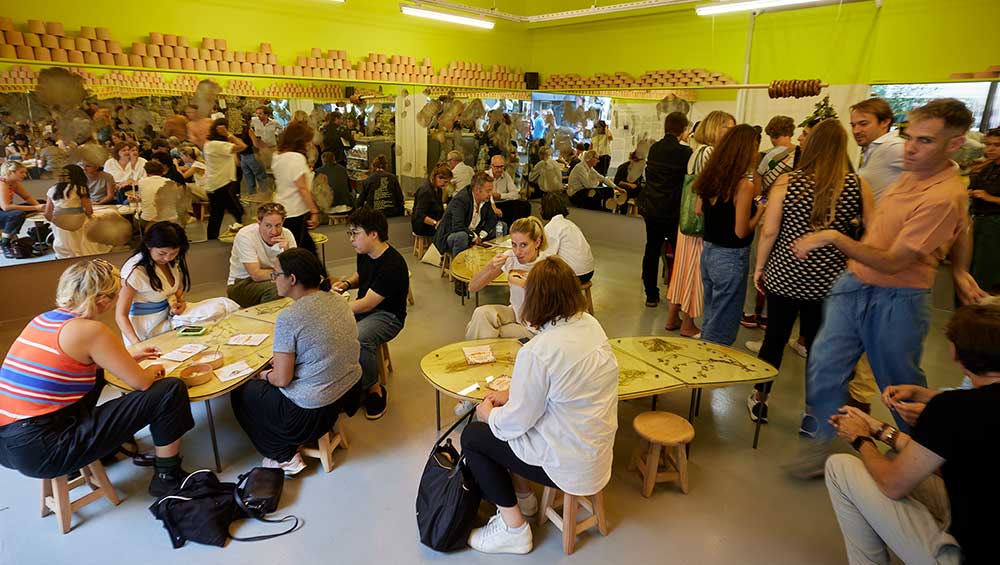
Wallowland by Cooking Sections at Büyükdere35, 17th Istanbul Biennial. Photo © David Levene.
Various venues, Istanbul
17 September – 20 November 2022
by VERONICA SIMPSON
What is a biennial for? For me, the best of the city-based biennials that now proliferate around the world are those that are less intent on competing for cultural kudos and driving up tourism and more interested in revealing a city to itself, while asking interesting questions about the wider world we inhabit. The Istanbul Biennial has done that right from its start in 1987, not least with its consistent commitment to critical thinking in its themes, and also its practice of finding new venues across this diverse and fascinating city with every iteration. For 2022, 10 out of the 12 official venues are new to the biennial, and some are fairly new to the city. More than 50 smaller venues are also participating. Is this scattergun approach a sign of fragmented focus or funding, or something more substantial to do with seeding and nourishing new communities?
Fortunately, it turns out to be the latter. As Bige Örer, director of the biennial since 2008, declares at the launch, this year’s Istanbul Biennial is all about composting. The theme was hatched during its extended, pandemic-triggered, three-year gestation, and multiple online conversations in 2020 and 2021 between Örer and this year’s curatorial trio of Ute Meta Bauer, Amar Kanwar and David Teh. They felt a new approach was needed, says Örer: “We acted on the thought that the art ecosystem has to continue in a different way after this crisis … We borrowed a concept from agriculture and, by adopting the method of composting as our guide, we [wove] the biennial as an event that focuses more on processes. In this edition, we wanted to support artistic and cultural practices that carry out long-term work involving their communities in their local spaces and, in this way, render positive transformation possible.”
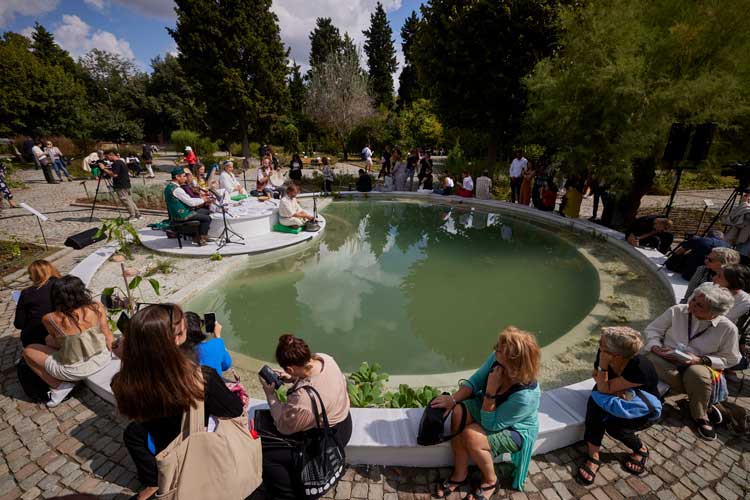
Installation by Laura Anderson Barbata at the Zeytinburnu Medicinal Plants Garden at the 17th Istanbul Biennial. Photo © David Levene.
With compost as the connecting motif, it seems appropriate that the official launch of the 17th Istanbul Biennial is in a garden, the Zeytinburnu Medicinal Plants Garden. It feels ancient, with its leafy groves and meandering paths, but it was established in 2005 as the first of its kind in Turkey. Drawing from its context – it is surrounded by hospitals and cemeteries of various faiths - its beds contain 700 varieties of medicinal and healing plants.

Installation by Laura Anderson Barbata at the Zeytinburnu Medicinal Plants Garden at the 17th Istanbul Biennial. Photo © David Levene.
In one particularly leafy corner of its 1.4 hectares, vermilion hammocks have been strung up, to create a communal place of rest – a winding red thread connects the hammocks through the treescape. The artist behind this project is Laura Anderson Barbata, a Mexican whose collaborative and community-driven practice explores responsibility, reciprocity and balance. These vivid red hammocks were made by weavers in Yucatán, whose origins can be traced back to pre-Colombian Maya, Taino and Arawak civilisations. Part of an ongoing project called Our History Is Not Found in a Book, it has had iterations in 2001, 2009 and 2021.
Looking back over the three intense preview days spent visiting as many as possible of the 50 projects dispersed across the Beyoğlu, Kadiköy, Fatih and Zeytinburnu districts, involving more than 500 artists, thinkers, writers, researchers and poets, as well as farmers, fishermen, ornithologists, ethnomusicologists and puppeteers, it feels as if we roamed across this hilly, multitudinous and diverse city much like the worms on whom the health and productivity of compost depends.
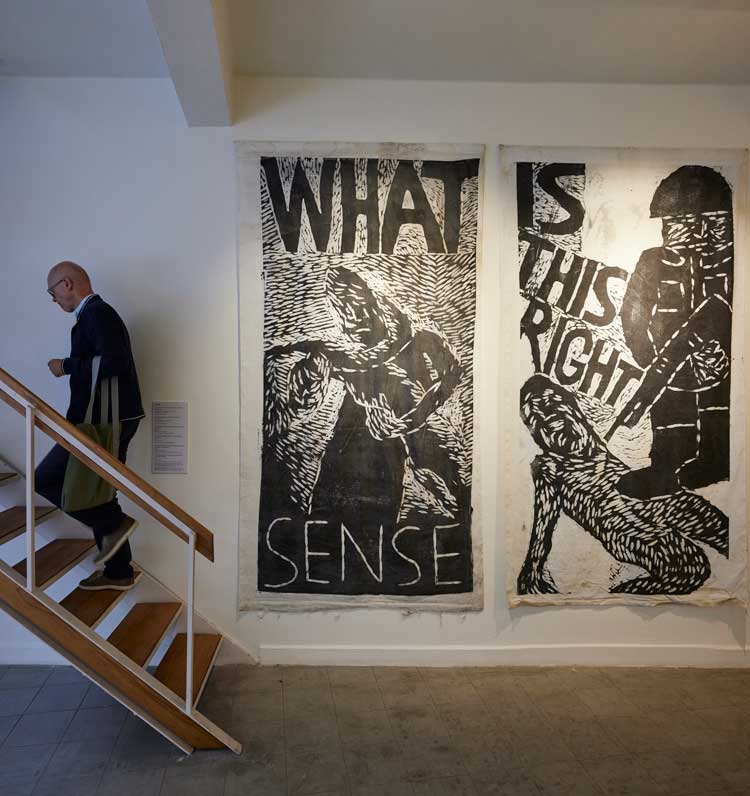
Barın Han at the 17th Istanbul Biennial. Photo © David Levene.
We scaled every level up to the top of a six-storey building, the Barin Han, to which the calligrapher Emin Barin added studio and artist workspaces alongside his own atelier, in 2019. For this biennial, every storey is transformed into a unique immersive experience, creating vibrant spaces for conversation.
Will those conversations continue after the biennial, as the directors and curators wish? Who knows, but the vibe being created on the ground floor by a DJ and open-for-experimentation, calligraphy workshop tables makes it seem like a space that locals could happily continue to use.
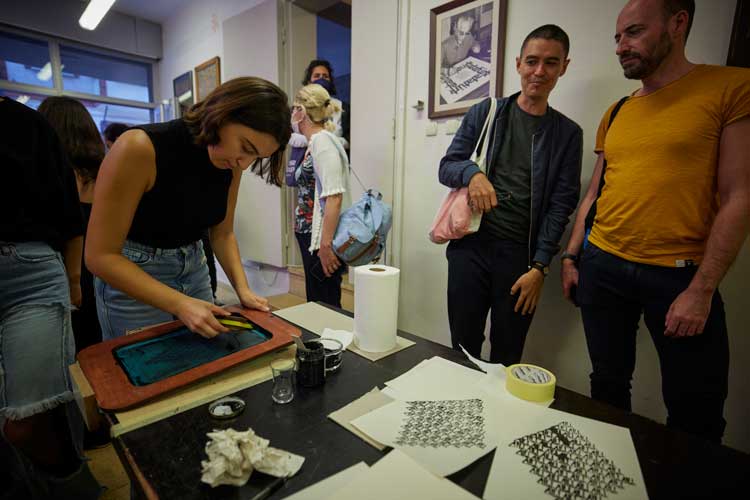
Barın Han at the 17th Istanbul Biennial. Photo © David Levene.
Discussions and collaborations have certainly fuelled an existing and highly successful shared arts space in the Kadiköy district on the Asian side of Istanbul, across the Bosphorus. Arthereistanbul was established in 2014 by Syrian artist refugees: initially a temporary meeting point, it has evolved into a thriving, three-storey centre of production and exhibition, with a darkroom, workshops, libraries and gallery spaces that are programmed and occupied all year round. One of its libraries, containing books dealing with the experiences of war, hosts Footsteps, a powerful exhibition by the journalist Çiğdem Öztürk, which comprises stories she has collected from the Istanbul refugee diaspora with photographs taken by Omar Berakdar, the founder of the arthereistanbul initiative. Here is an existing compost heap of creativity, already nourishing its population.
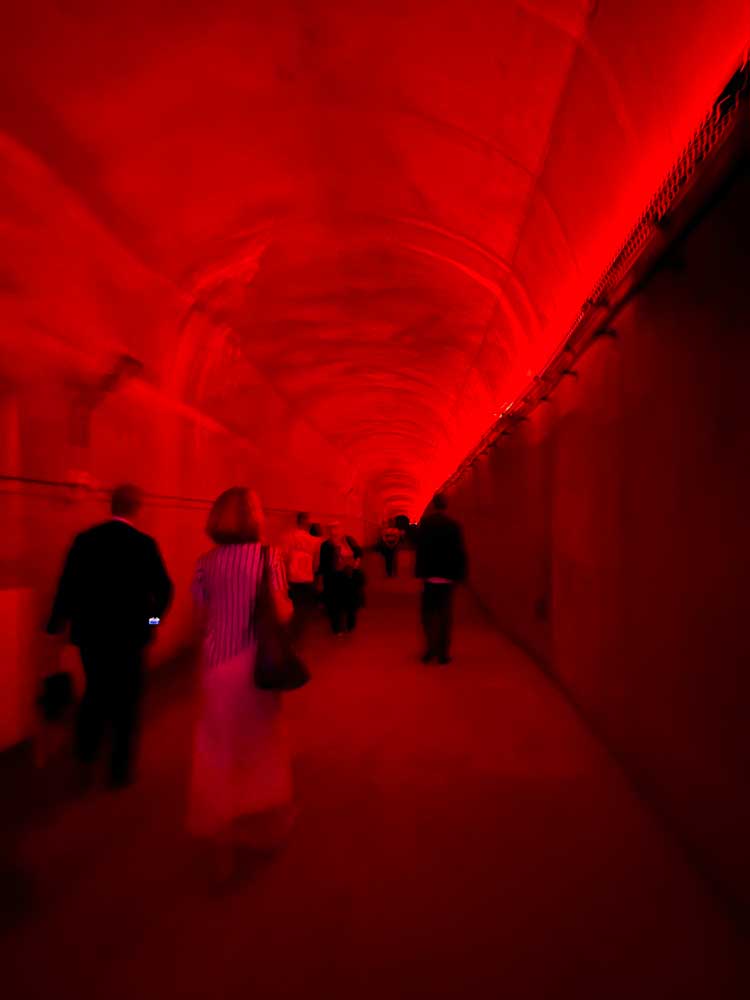
Carlos Casas, Cyclope. Sound and light installation, 17th Istanbul Biennial. Photo: Veronica Simpson.
We then burrowed down into a disused Metro tunnel beneath Taksim Gezi Park. Drilled in the 1990s to serve the construction of Taksim Metro station, it is an impressive 257 metres long, 4 metres wide and 4.25 metres high, though the height starts to close in around you as you walk deeper into Carlos Casas’ disturbing sound and light installation celebrating the tunnel’s reincarnation as a space for exhibition. The work of the Spanish-born, Paris-based film-maker explores the legacy of physiological and ecological trauma, and his installation, Cyclope, combines field recordings with samples taken from sonic experimentation for mass control and torture. This deeply disturbing but compelling soundtrack is intensified by the colour shift in the immersive lightscape, from cool blue at the entrance to a hellish red as you get closer to its deepest, darkest corners.
We roamed freely around the expansive domain of a new cultural hub, Müze Gazhane, a disused gasworks that, thanks to a long campaign by local residents, reopened in 2021 after extensive restoration and refurbishment, offering multiple stages, workspaces and exhibition venues, all currently fully programmed for the biennial.
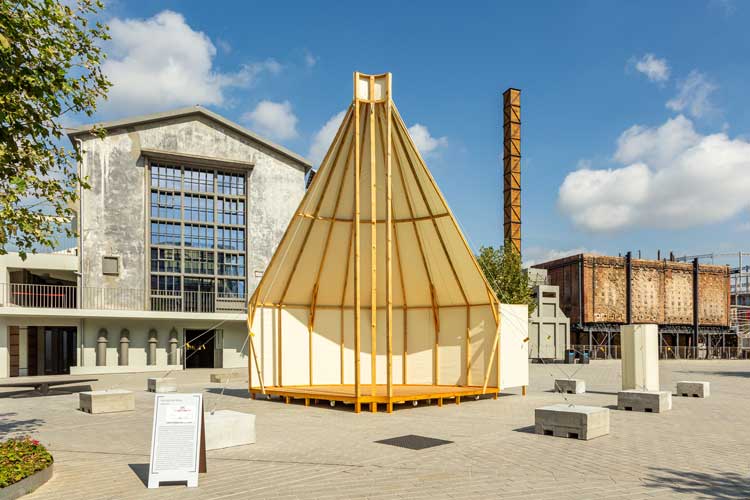
Ângela Ferreira, Zip Zap Sirk Okulu, 17th Istanbul Biennial. Photo: Sahir Ugur Eren.
There is also a generous public square, in which the artist Ângela Ferreira has constructed her Zip Zap Circus School (2000-02), a blend of two unrealised but utopian structures, one a modernist museum by Mies van der Rohe and the other a community school designed by the Portuguese-Mozambican architect Pancho Guedes. The result is a cloth and wood model of a “building that was never built”, a symbol of potential, as well as unfulfilled dreams.

Wallowland by Cooking Sections at Büyükdere35 at the 17th Istanbul Biennial. Photo © David Levene.
Sustenance for body and brain were provided by the London-based artist duo Cooking Sections, who have taken over the gallery Büyükdere35 and turned it into a traditional muhallebicisi (pudding shop), where buffalo-milk based puddings are served. Food as a trigger of conscience and consciousness is the stock in trade of the Turner-prize-nominated duo, Daniel Fernández Pascual and Alon Schwabe, who here showcase their long-term research into the displacement of traditional water buffalo herds and herding communities whose watery hinterlands beyond the Istanbul metropolis are rapidly disappearing amid a surge of construction.
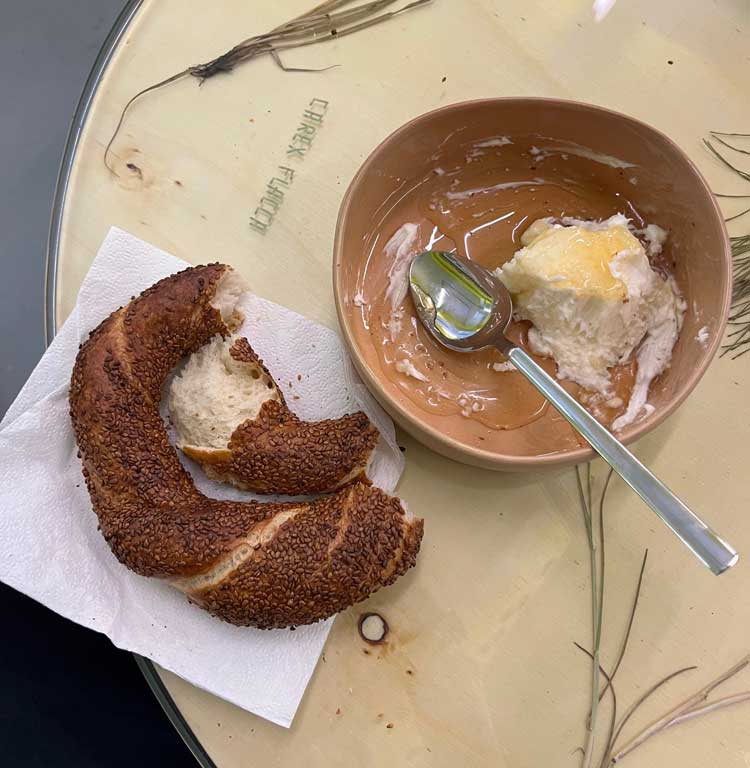
Clotted cream and Pretzel, Cooking Sections installation, 17th Istanbul Biennial. Photo: Veronica Simpson.
Wallowland (2022) is not just a series of delicious puddings (a clotted-cream dessert, served with pretzels and honey, was particularly fine), but an installation commissioned for this biennial where research by Cooking Sections and their Istanbul collaborators is displayed as scratched maps on mirrored glass, with informative artwork revealing their findings from surveys into the multiple ecologies that are under threat from the loss of buffalo terrain. A backdrop of traditional songs collected from all over the world in tribute to the water buffalo completes the immersive experience. To keep this issue at the forefront of public consciousness, Cooking Sections has launched an annual Water Buffalo festival, the first iteration of which took place on 17th September.
The project echoes another radical festival initiative, launched by the Hrant Dink Foundation, a charitable organisation set up within the offices of the Armenian bilingual newspaper Agos to mark the assassination of the Armenian journalist Hrant Dink outside its doors in 2007. After the government banned a conference they organised in 2019 to discuss the social, cultural and economic history of Armenians, the foundation instead held a Dumpling Festival, as a way of getting round the ban and enabling people to meet and talk.
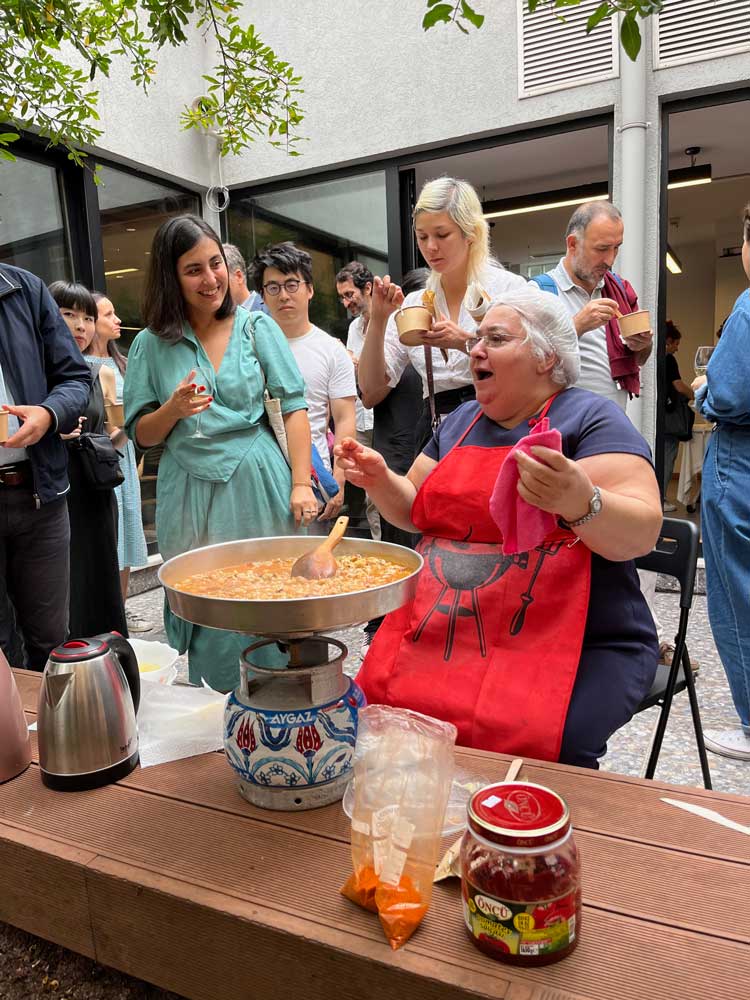
Dumpling Post demonstration at Hrant Dink Foundation, 17th Istanbul Biennial. Photo: Veronica Simpson.
The Dumpling Post, a local newspaper covering culture and social history, was launched at the same time and endures online with an occasional print edition, featuring dumpling recipes as well as stories, essays and opinion pieces. Even under the notoriously repressive Turkish government, conversations – along with dumpling ingredients – must flourish.

Çinili Hamam at the 17th Istanbul Biennial. Photo © David Levene.
Restoration and inspiration to alleviate our tired bodies and minds was provided at the Çinili Hammam, located in the Zeyrek residential neighbourhood of the Fatih district. One of the earliest hammams designed by the chief ottoman architect, Mimar Sinan, it is an outstanding example of Ottoman architecture. Although originally lined in distinctive blue and white Iznik tiles (many of which are now in the world’s leading art and design collections, including the Victoria and Albert Museum in London), its newly and expensively restored interior is of pale plaster and marble, awaiting its return at the end of next year to a full-time hammam, of the most luxurious kind.
For the duration of this biennial, however, and a few months beyond, it will be open to the public, and currently displays one of the most profound, poignant and delightful works of the biennial: Papua New Guinea-born artist Taloi Havini’s sound installation Answer to the Call (2021), commissioned and produced by the TBA21-Academy (it first appeared at last year’s Venice Architecture Biennale). It combines the sonar pulses of a research vessel exploring damage to the coral reef along the South Pacific Ocean floor with recordings of her uncle, a skilled musician, playing traditional folk music in her home region of Bougainville, with its lilting call and response rhythms, as well as the Bolivian musician Mario Celestino playing the flute. “The idea was to cross the ocean with our instruments,” says Havini.
Only once during the three days do we enter a traditional space of cultural display. The Pera Museum, a grand, 19th-century neoclassical building that was originally a hotel, is renowned for its collection of orientalist paintings, ceramics and Anatolian weights and measures. Here, the top three floors have been given over to the biennial and there is a lot of really striking work on offer. Highlights included films by the Afghanistan-born, New York-based artist Lida Abdul, whose work probes the legacy of western intervention in her country. White House (2005) shows Abdul, dressed in black, standing in the rubble of what had clearly been an important building (judging by its few remaining neoclassical pillars), in the middle of a seemingly barren landscape, determinedly painting every surface with thick white emulsion. This turns out to have been a former presidential palace, bombed in a US air strike. Abdul’s In Transit (2008) features schoolchildren wrapping kite string around a wrecked Russian military aircraft, as if they could make it fly. Alice Miceli’s heart-wrenching photographic series In Depth (Minefields), of natural landscapes in Cambodia, Bosnia and Colombia haunted by the presence of landmines, also left a lasting impression.
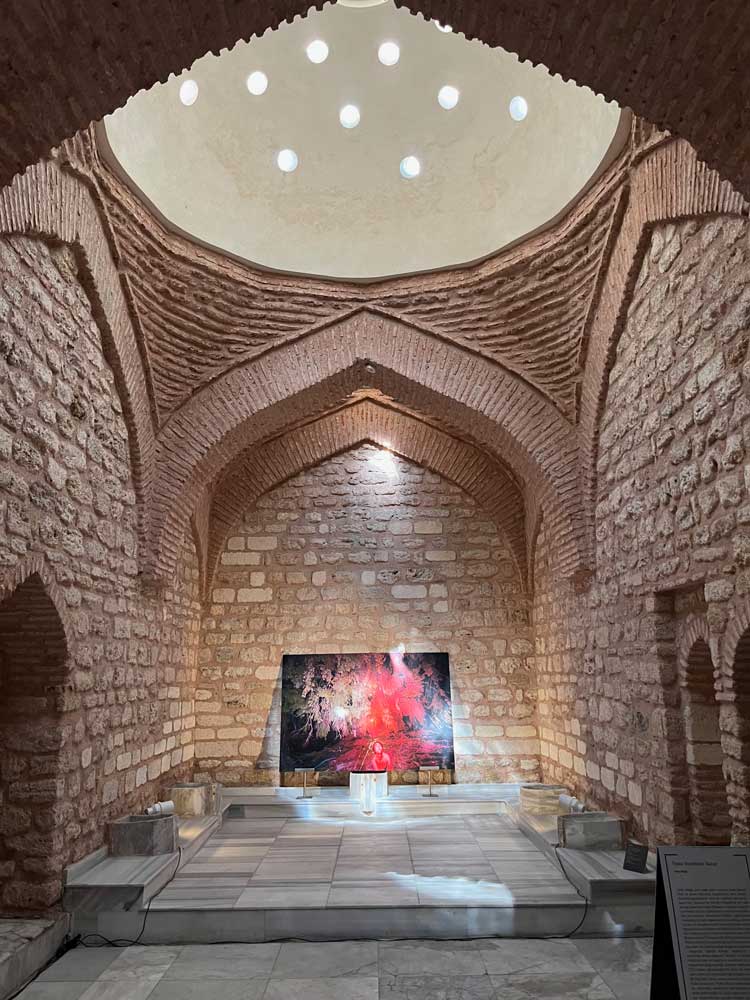
Human Spring series by Lieko Shiga at Küçük Mustafa Paşa Hammam. Photo: Veronica Simpson.
This venue is one of the two that has been used before for the biennial, the other being the 15th-century Küçük Mustafa Paşa Hammam, the undulating, brown brick contours of which have been transformed into a contemplative shared space for talking and reading. Its resonant interiors are fully exploited by the sound artist and composer Tarek Atoui. Here, he extends his Waters’ Witness work – recording and transmitting the sound of the world’s port cities – along with fellow Paris-based collaborator Éric la Casa and a group of local sound recordists to weave in the sounds of Istanbul’s working harbours. His second work, Whispering Playground, is a series of acoustic workshops that will run throughout the biennial, teaching children and youngsters how to explore the percussive landscape of water through various found objects and recording technologies.
.jpg)
Tarek Atoui (centre) leads a Whispering Playground workshop in Küçük Mustafa Paşa Hammam. Photo: Veronica Simpson.
Deeper inside the hammam’s labyrinthine structure, the Australian artist Newell Harry displays some of his impressive archive of foraged material – stories, documents, films and books revealing layers of cultural friction brought about by migration.
There was so much more to see, so much we didn’t see – the journeys between venues are not helped by Istanbul’s legendary traffic jams – but we managed to witness an inspirational performance by the US community theatre group Bread and Puppet Theater, in a waterside amphitheatre in the grounds of Istanbul Bilgi University. Led by John Bell, one of the original members of this radical group founded in 1963 by Peter Schumann on New York’s Lower East Side, this show was the result of a two-week, co-creative immersive session of story- and puppet-making. The newly hatched play, exploring the pernicious influence of social media and consumerist lifestyles, was performed with vigour, flair and utter commitment by the participants, most of whom were aged between 10 and 16.
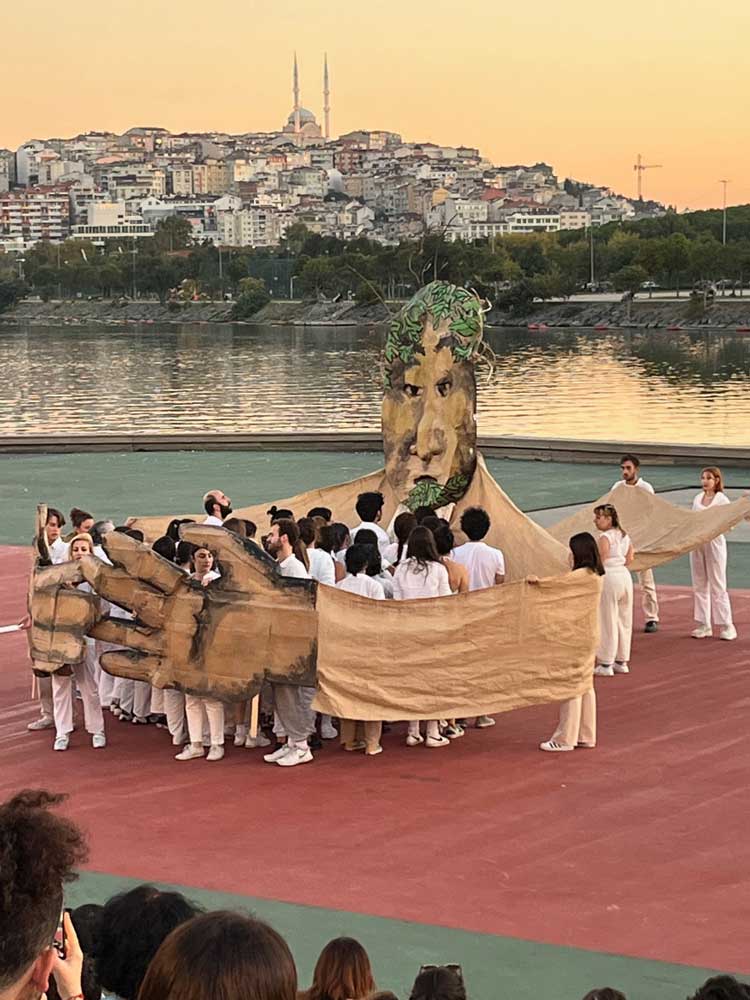
Bread and Puppet Theatre performance. Photo: Veronica Simpson.
These children – and those involved in Atoui’s sound workshops – are just a few of the thousands of locals whose exposure to art, to the themes of freedom of expression and self-determination, will help to determine the power and influence of this biennial. Örer is convinced of the power of the festival to fertilise imagination as well as artistic expression. She told me: “I think the Istanbul Biennial has contributed to the development of contemporary artistic production and knowledge production around contemporary art. It has built a bridge between the art community of Istanbul and the rest of the world. It has also transformed the infrastructure of the city. Because if you work in a space, you also transform a space and … sometimes we see that the spaces turn out to be long-term contemporary art spaces. For example, we used a (temporary) space in 2007 and it is still an arts-run space. You really see how the biennial has transformed a space but also people. Many people who have worked in the biennial have become really well-known artists, curators, writers, editors, authors, production teams. It is a learning space. They say the biennial is a school. And then, wherever we go, we transfer this knowledge to other cultural institutions. Also, there’s the fact that it is creating this public space, where people are looking at the world, they are discussing; sometimes they are critical, sometimes they appreciate it. It creates this really important public discussion. As the biennial is also free of charge, we are able to reach out to more than half a million visitors. This is very important because we sometimes feel, in Turkey, it’s getting polarised. People with different social, cultural, political backgrounds, they are not meeting each other any more. The locations are more segregated, where you live, where you work. The biennial is a space for everyone.”
How the biennial manages to continue this programme of propagating new growth in artistic and critical expression under a government that treats dissenters harshly is a source of wonder. Some feel that it originally got away with its critiques because the Turkish government didn’t take the visual arts seriously. Örer says: “For a long time, contemporary art was under the radar, it’s true.” It helps, she points out, that the biennial does not get any government funding. Instead, it is financed by many Turkish businesses - which appreciate the influx of curious cultural tourists - plus international embassies and arts organisations with a presence in Istanbul. I also noted that, while criticism of corrupt and oppressive regimes is writ large in many of the international exhibits, there is no overt criticism of Turkey’s. Örer concurs: “Sometimes I think when it’s not so much [in] your face, it doesn’t become a big deal.” Long may the biennial’s subtle but piercing expressions of soft power thrive on this fertile bed of compost.